Melnik, Bulgaria: Best Things to Do & Facts About Melnik
Melnik, Bulgaria is famous for its delectable Melnik Wines and its natural phenomenon, the sandstone Melnik Pyramids. Melnik is also known for being Bulgaria’s smallest and warmest town, as well as for its interesting history and staggering architecture.
In this guide, you’ll learn about the best things to do in Melnik, how to travel to the quaint Bulgarian town, and the most important facts about its history and architecture.
Ready to explore?
Let’s begin!
Disclaimer: This post contains affiliate links. If you purchase something through one of them, I may receive a small commission at no extra cost to you. Thank you for helping me create free content on this website!
The 7 Best Things to Do in Melnik, Bulgaria
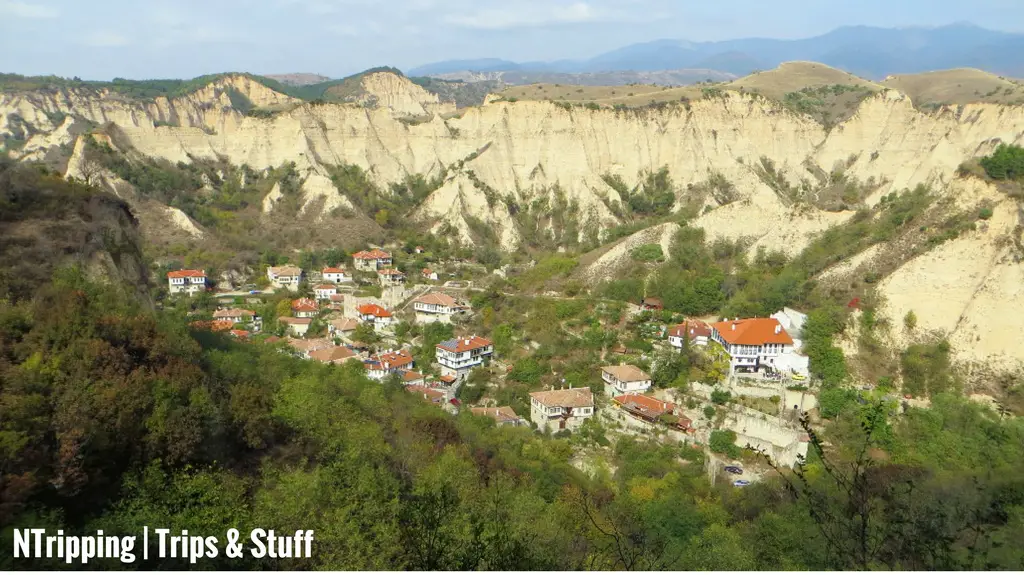
Melnik is worth visiting for the mind-blowing sandstone Melnik Pyramids, the delectable Melnik wines, and the well-preserved Bulgarian Revival architectural style houses. Melnik is also worth going to for the delectable cuisine and the fascinating history.
Below, you’ll find the best things to do in Melnik. Let’s dive in:
1. Discover the Best Views of the Melnik Pyramids
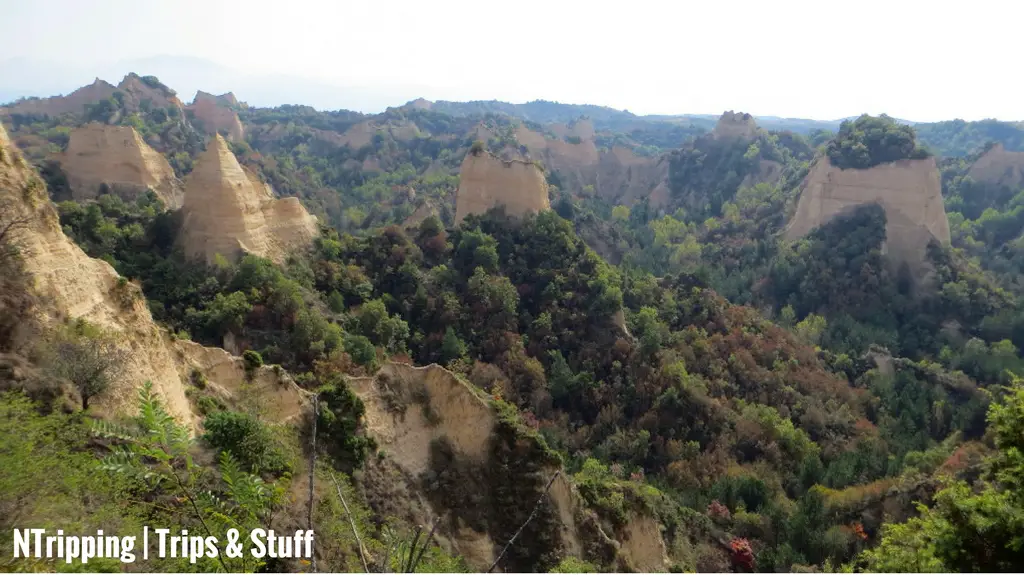
The fascinating rocks you see everywhere around Melnik are made of sandstone. Nature’s forces and time have carved the unique formations, known as the Melnik Pyramids.
St. Nicholas Plateau reveals the most breathtaking views of the rock formations. The hike is worth the effort.
To get to the top of the plateau, follow the sign from the main street. You’ll need to walk a narrow alley up the hill for about 20 minutes.
Once you reach the highest point, the panorama will leave you in awe.
On one side of the plateau, you’ll see Melnik cuddled between the sandstone hills. On the opposite side, you’ll discover even more of the magnificent sandstone formations, which are not visible from the town.
One of the valleys hides a gruesome story. At Zli dol (Evil Valley), in the late 19th century the Ottomans hung 12 local citizens for conspiracy.
Be careful when taking photos of the Melnik Pyramids as the sandy soil can be slippery.
2. Explore the Medieval Ruins at St. Nicholas Plateau
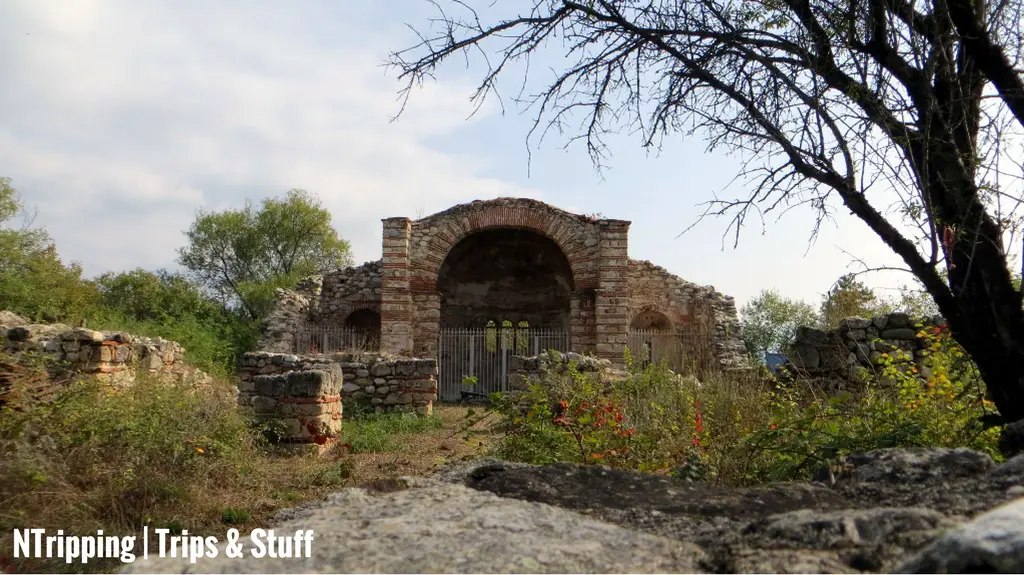
Since you’ve already hiked to St. Nicholas Plateau, let’s find out what other treasures you can explore there.
Apart from the best views of the Melnik Pyramids, the St. Nicolas Plateau hides the ruins of churches, monasteries, and a medieval fortress.
The biggest and best-preserved church on the plateau is the St. Nicholas Church. It dates back to the 12th century and was built on the same grounds as an earlier Thracian sanctuary.
On the edges of the plateau, you’ll find the walls of the Despot Slav’s Fortress. It’s equipped with five couples of watchtowers, which have defended the town since the 13th century.
The fortification walls and the high sandstone rocks, surrounding Melnik, made sure no one could approach the city without being noticed.
Parts of the fortress walls are well-preserved. Unfortunately, most of the structures didn’t survive the devastating 1904 earthquake.
It was the strongest 20th-century earthquake in Europe. It damaged critically most buildings on the St. Nicholas Plateau. The rocks slipped down the hillsides and were later used as a building material for the houses, hence disappearing forever.
The last of the buildings I suggest you visit on the plateau is the St. Virgin Mary Spileotisa Monastery. It’s a small cloister, which was recently renovated.
Beneath the building, you’ll find a small man-made cave. Whenever a nun felt she had sinned in her thoughts, she would punish herself by spending time in the cave.
3. Learn About the Famous Melnik Wines
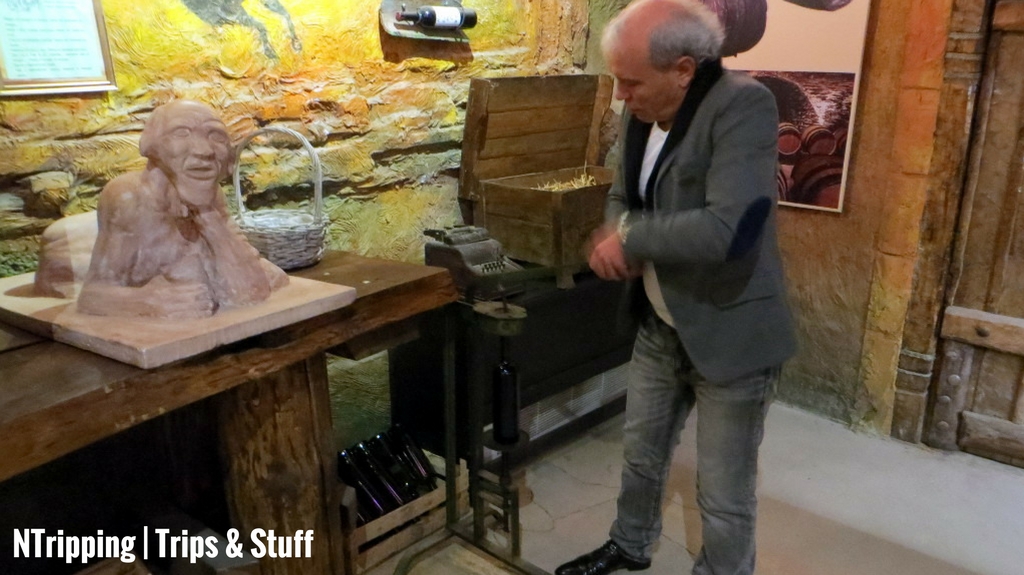
You can try the famous Melnik wines in any eatery on the main street of town.
However, the best place to learn about the vine growing and wine production traditions of the region is at the Melnik Museum of Wine.
Established in 2013, the museum hosts a small exhibition of wine production tools and machinery, information signs, and wine-drinking vessels.
My recommendation is to buy a ticket that includes wine tasting to fully enjoy the experience.
Even if you’re not a huge wine lover, don’t miss to try the dry red wine, produced from the locally grown Wide-leafed Melnik Vine. It’s indigenous to the region and attempts to grow it elsewhere have failed numerous times.
Peculiarly, the most famous Melnik wine aficionado was Winston Churchill.
Historians say that a British officer, stationed around Melnik during World War II, brought several bottles of Melnik wine to England. The officer and Churchill were acquainted and shared a common love for good wine.
Later it was reported, that 300 liters of the delectable Melnik wine were delivered each year for a 10-year-long period to Churchill’s personal cellar!
4. Visit the Magnificent Kordopulov House
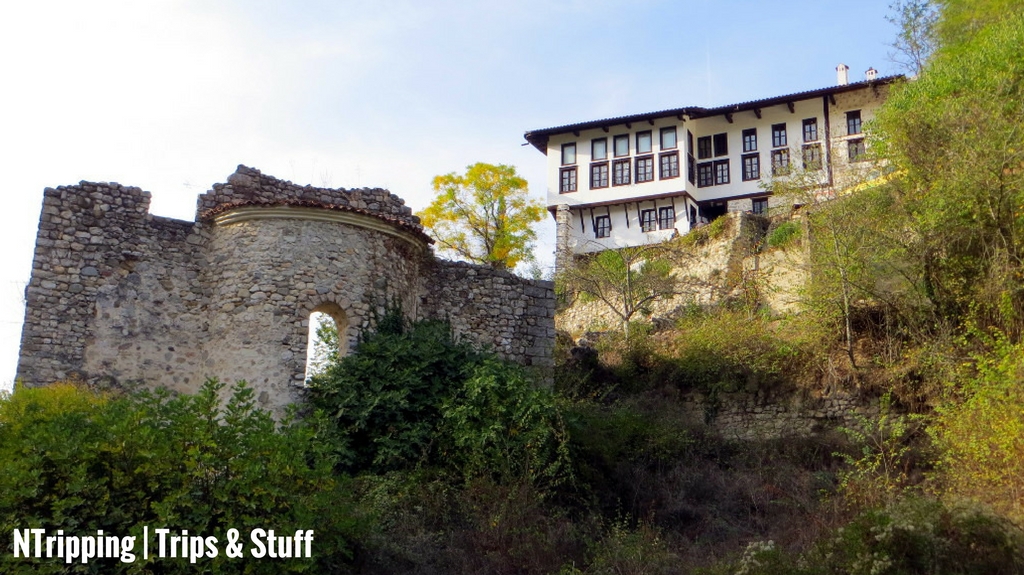
Melnik is, in fact, an architectural park. Its houses represent the Bulgarian National Revival style.
The biggest, richest, and most visited house in town is the Kordopulov House. It’s the largest National Revival house in the Balkans and a private museum. Its history is full of mysteries, betrayal, and drama.
The Greek merchant Kordopulos bought the house in 1754. The gorgeous edifice consists of a ground floor, a semi-basement, and a bay floor.
On the ground floor, you’ll find the wine cellar. The semi-basement was used for economic needs. On the bay floor are the rooms intended to be inhabited.
The huge rooms on the bay floor are built in such a way that the sun shines in all day. Venetian frescoes, wooden carvings, and stained glass adorn the chambers.
Beneath the house, you can still spot the ruins of St. Barbara Church. It was built by the merchant’s family for their personal use.
5. Venture to the Gorgeous Rozhen Monastery
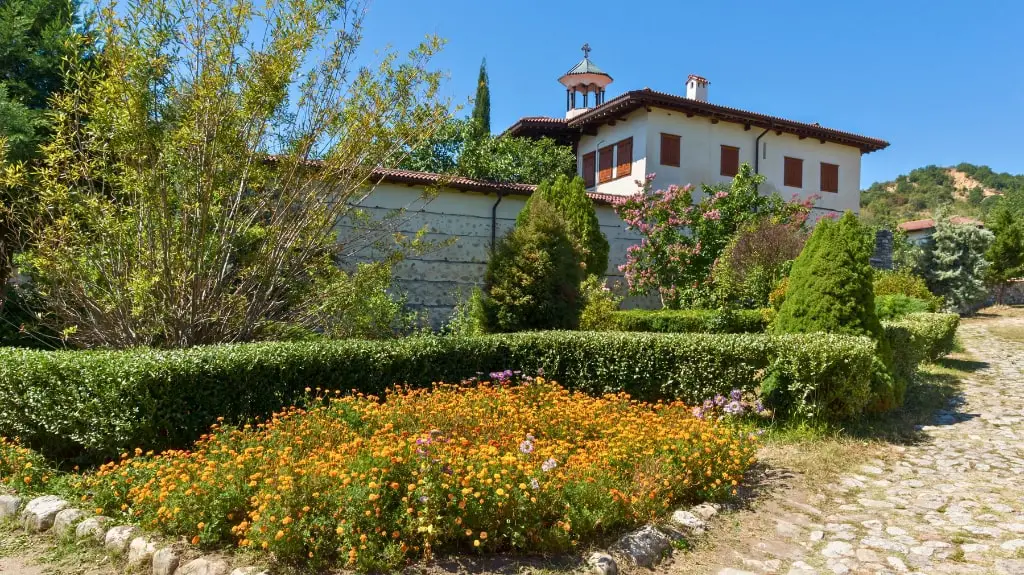
You can reach Rozhen Monastery in a few minutes from Melnik.
It’s the biggest cloister in the Pirin Mountains and the best-preserved medieval monastery in Bulgaria.
Rozhen Monastery is worth visiting for its mesmerizing frescoes, its intricate iconostasis, its vibrant gardens, and its peculiar ossuary.
The cloister dates back to the 13th century. The main church is from the 15th century.
The main monastery building has an irregular hexagon shape. Its wings stem from different periods.
Surrounded by the main monastery building is a beautiful garden. In the middle of it, you’ll see the church.
6. Find the Hidden Gems of Melnik, Bulgaria
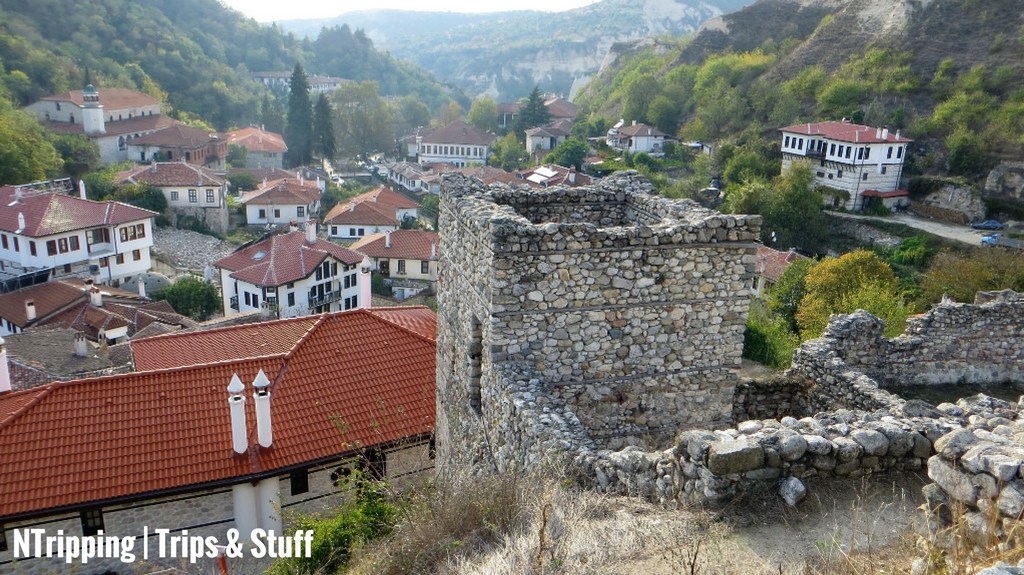
Several other fascinating buildings will enchant you in town.
- Bolyarska House. The former home of the ruler Despot Slav, whose fortress on the St. Nicholas Plateau you hopefully visited, can be seen from almost everywhere in town. The house has three stories and even in its current ruined state is quite impressive.
- The Historical Museum of Melnik. The collection hosts a small exhibition, where you can see the difference in the clothing and lifestyle of rich wine producers and merchants and the ordinary folks of the region.
- The Turkish City Hall. The building of the former konak is currently being renovated. Local museum workers hope their exhibition will afterward be moved there so that they can display a larger number of museum pieces from the area.
- Uzunovi House. You’ll find the imposing structure next to the konak. Currently, it hosts a hotel. In the past, the building served as a Turkish prison. It has an open backyard, where prisoners could go out for fresh air on their daily walks.
- St. Antony Church. Built in 1868, it’s one of the last functioning churches in Melnik. It’s also the only one in Bulgaria, dedicated to this saint. Peculiarly, it’s one of only two temples in Europe, dedicated to healing the mentally ill. It’s believed, that spending several nights in the church would heal a person. The walls of the church are not covered in scenes from the bible, which are typical for East Orthodox churches. Instead, paintings of flowers adorn the walls to establish a calming atmosphere.
7. Sample Delectable Traditional Bulgarian Dishes
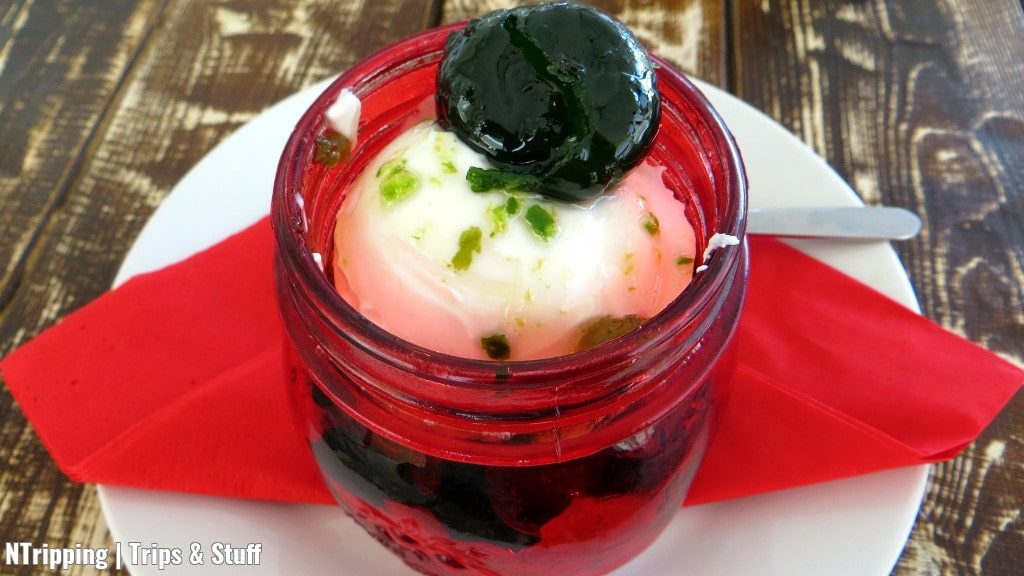
Melnik’s main street boasts countless restaurants, eateries, and wine houses. Waiters invite you to come in for a sit-down meal or a wine tasting. It’s hard to resist their offers.
Here are the traditional Bulgarian dishes you should sample in Melnik’s restaurants:
- Salads. Bulgarian salads feature fresh, scrumptious vegetables, tasty white-brine cheese, and amazing dressings. You should try Shopska salad and green salad.
- Soups. In colder months, order a chicken or a bean soup to warm you up. In the summer months, try tarator. The yogurt-based cold soup will redefine your perceptions of deliciousness.
- Grilled meats. Your choice of grilled meats is almost endless. Try the typical meatballs or the gigantic skewers, if you’re feeling adventurous.
- Red wine. Wash down your lunch with delectable Melnik wines. They’ll enchant you with their rich complex aromas of leather and dried fruits.
- Yogurt with fig jam. Bulgarian yogurt is world-renowned for its excellent taste and health benefits. Paired with a homemade fig jam, it’ll make your taste buds skyrocket to heaven.
10 Fun and Interesting Facts About Melnik, Bulgaria
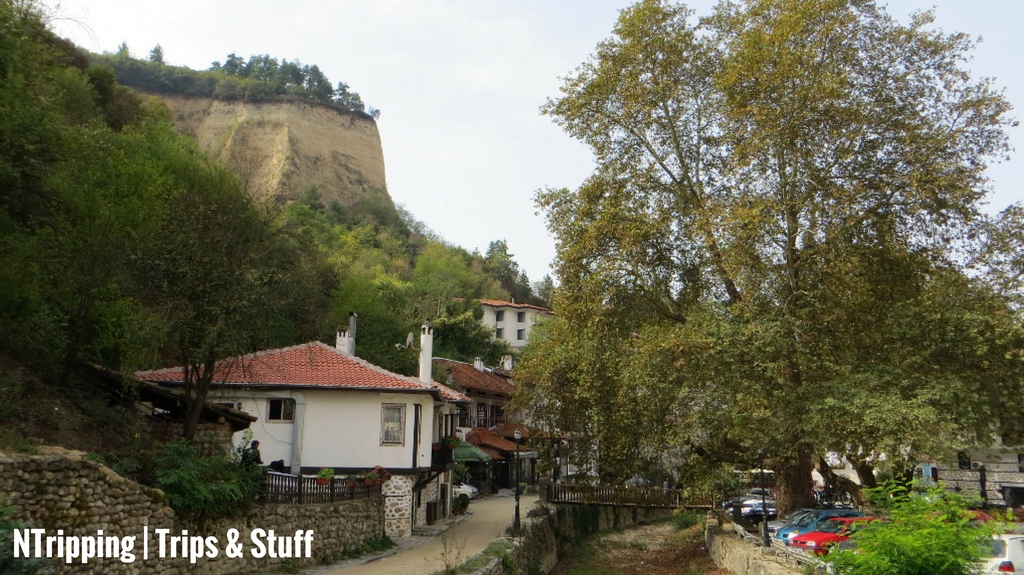
These are the most incredible 10 facts about Melnik you should know:
- Melnik is Bulgaria’s smallest town. Situated in the southwest of the country, near the borders with Greece and North Macedonia, its current population is only 200 people.
- It’s also the country’s warmest town. The mild climate is suitable for people with respiratory, kidney, and rheumatic health problems. And of course, it’s perfect for vine growing and wine aging!
- Wine is the most important industry in Melnik. The main source of income for the people of the Bulgarian town was and remains wine production and trade.
- It was once an important city with nearly 25,000 population. Several wars, the main road being moved away from the town, and an infection to the vines, causing a huge portion of the population to lose their livelihood, shrank the size of the town drastically.
- Winston Churchill is the most famous fan of Melnik wine. The region is world-renowned for its red wines. The most prominent lover of the locally grown Broad-Leafed Melnik wine (Shiroka Melnishka loza) was Winston Churchill.
- You’ll find several centuries-old plane trees in town. The oldest one dates back 800 years and will greet you at the entrance. Another huge 700-year-old plane tree stands in the town’s center. Several magnificent trees are growing just a few meters after the town’s last house.
- Melnik doesn’t have any back alleys. Besides the relatively wide main street, there are no other streets in the town. The houses on the slopes of the hills are built so close to each other, that it feels like they are hugging. There’s no room for a single tree to grow, let alone a street to pass between them.
- The town is almost 1,200 years old. During this time, it was ruled by the Thracians, Slavs, Byzantines, Bulgarians, Greeks, Serbs, and Ottomans. Basically, by everyone who passed through.
- During the town’s glorious days, there were 70+ churches in and around Melnik. Nowadays, most are in ruins. Only three are still functioning.
- Melnik is an architectural park. The town’s special status means that new buildings have to comply with the architecture of the monuments and incorporate the same architectural style.
How to Get to Melnik, Bulgaria: The Best Transport
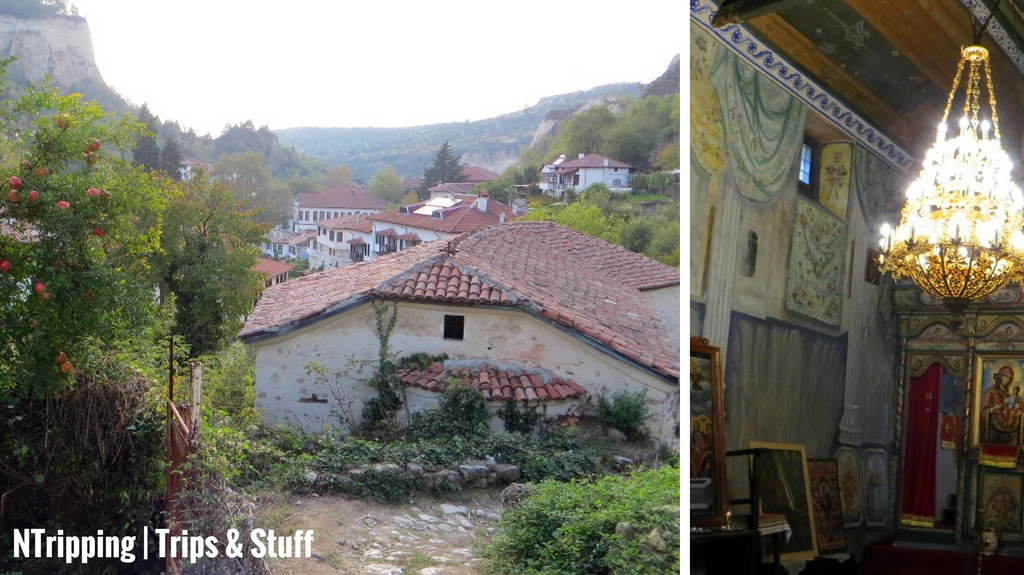
To get to Bulgaria’s smallest town, you have two options:
If I were you, I’d choose the second option for its convenience.
During the guided tour, you’ll be accompanied by a knowledgeable English-speaking guide. You’ll visit Kordopulov House, the Wine Museum, and Rozhen Monastery.
You’ll sample local wines and learn about their production in a winery with scenic views.
The transportation is in a comfortable minibus.
🚐 Join the best-rated small-group guided tour from Sofia to Melnik here.
Where to Stay in Melnik, Bulgaria: The Best Hotels
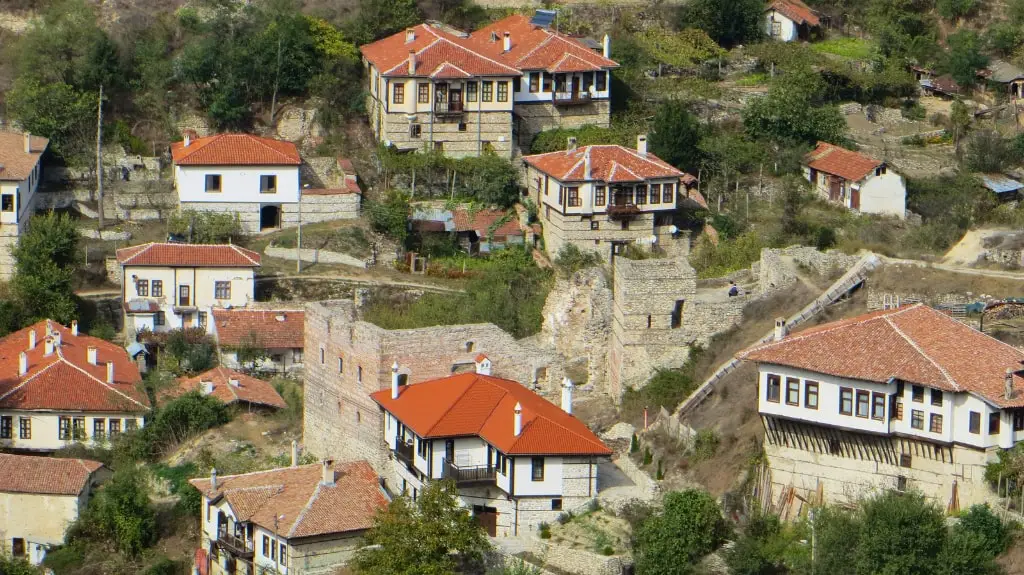
Although I recommend visiting the Bulgarian town on a day trip from Sofia, you might want to spend a few days in this charming region.
Below, you’ll find the best hotels to stay in Melnik:
📍 Zornitza Family Estate. Three swimming pools, two restaurants, and a wellness center will pamper you during your stay.
📍 Manoleva House. The rooms in this gorgeous hotel, built in the Bulgarian National Revival Style, will enchant you with their intricate decor.
📍 Hotel Slavova Krepost. This charming, budget-friendly hotel will feel like a visit to your favorite Bulgarian grandma.
Everything You Need To Know About Melnik, Bulgaria
And there you have it – everything you need to know about Melnik, Bulgaria.
The country’s smallest and warmest town enchants with its nature, architecture, history, and cuisine.
Whether you want to try the famous Melnik wines, admire the National Revival-style houses, climb steep hills to see the peculiar sandstone Melnik pyramids, or explore the nearby Rozhen Monastery, now you know how to plan your visit.
Before you go, let me ask you this:
What’s the one thing about Melnik that amazed you the most?
Let me you in the comments below!
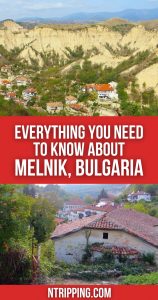
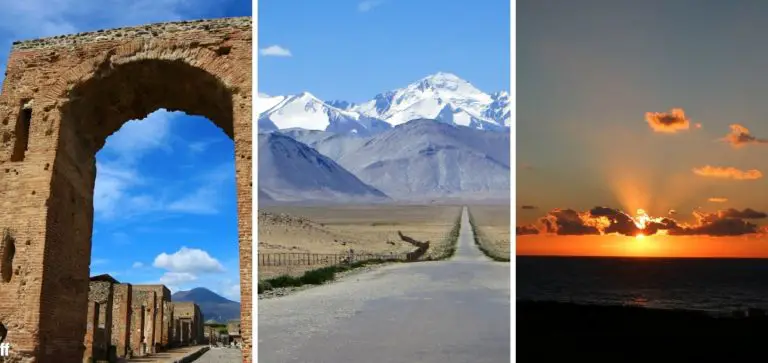

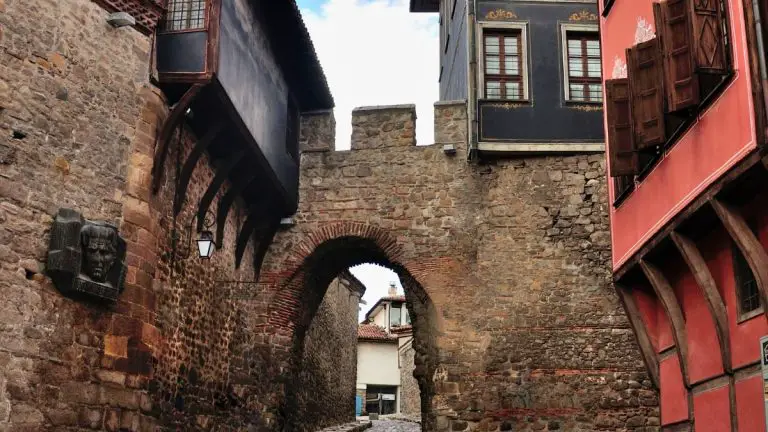

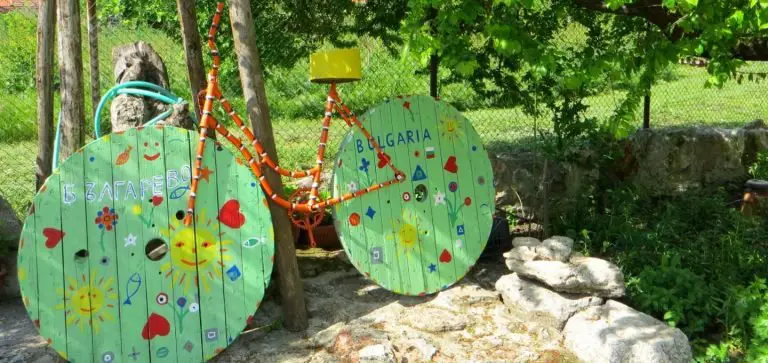
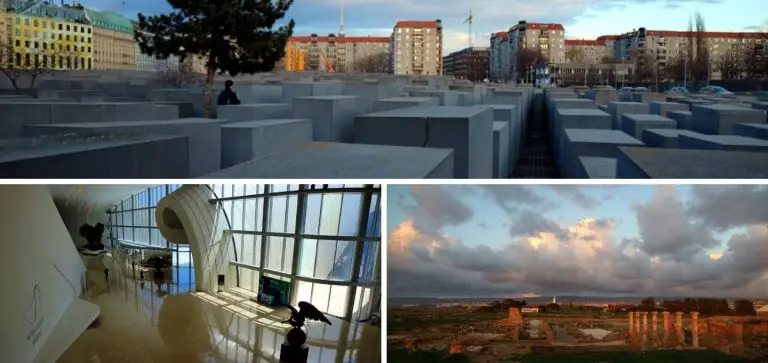
Naddya, thank you very much for compiling this gem of an article! It was super interesting to learn so many new things about Melnik.
I am not a fan of dry wines, but I will definitely try the broad-leafed one! I was in Melnik in 2008 and back then I was not that curious of a traveller, so I only admired the sandstone pyramids and unique ambience of Melnik.
Cheers,
Svet
Svet,
I think you’ll like Shiroka Melnishka Loza. If not, try the dessert wine. It was fantastic, and I’m really a dry red wine lover ;)
And definitely go up the St. Nikola plateau for the best view of The Melnik Pyramids and the ruins!
Cheers, N.
Thanks for giving me heads up about the dessert wine. I will definitely quench my thirst with that… and with the breath-taking view of the plateau :) Or, probably combine them both :)
Just be careful when hiking the plateau – the earth gets slippery even by the smallest amount of rain…
As for wines, just talk to the staff at the Wine Museum about your taste, I’m sure they’ll have the right recommendation for you!
Alright, I will :) That is not really a Wine Museum, by the way. The only one is in the vicinity of Pleven :)
The one in Melnik is rather new, est. 2013. Not sure what makes a museum a real museum, to me it looked real enough ;) There were enough items on display and enough information about wine making and vine growing. And there was wine tasting!
Never been to the Pleven museum of wine, but I’ll add it to my wish-list.
Yes, you should definitely pay it a visit. It’s situated in a cave and has wines that are more than 90 years old.
Wow, only 200 inhabitants, but still a great little town! and located in such lovely scenery. I’ll add it to the list of things to see in Bulgaria for sure. I really want to see Veliko Tarnovo and Plovdiv but this is lovely too.
egodiary.com
Melnik is a real gem! Just make sure you only climb to the plateau if it’s not raining as the sandy hills become very slippery in no time. Veliko Tarnovo and Plovdiv are also worth a visit, so is Sofia (check my latest post about the capital of Bulgaria here: https://ntripping.com/sofia-bulgaria/) and the small area of Bulgaria allows visitors to actually see a great many diverse places within just a few days ;)
Let me know if you need help planning your trip to Bulgaria, I’ll be happy to help :)
Cheers, N.